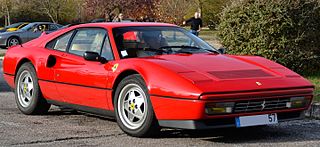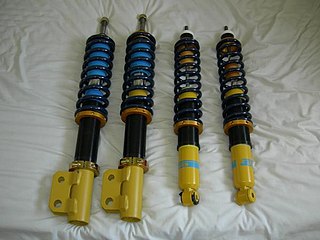Caterham Cars is a British manufacturer of specialist lightweight sports cars established in Caterham, Surrey, with their headquarters in Crawley, Sussex. Their current model, the Caterham 7, originally launched in 1973, is a direct evolution of the Series 3 Lotus Seven designed by Colin Chapman. In the 1990s the company made the Caterham 21, a two-seater soft top alternative to the MGF and Lotus Elise,. A track-only car, the SP/300.R, a joint project with Lola was released for customer testing in 2010 and was scheduled for release in 2013. On 27 April 2011, Team Lotus owner Tony Fernandes announced that he had purchased Caterham. On 2 April 2021, news was leaked that Caterham Cars was acquired outright on 31 March 2021 by VT Holdings, Japanese importer for the Caterham Seven since 2009. As well as being a Caterham importer, VT also imports Lotus cars and Royal Enfield motorcycles into Japan.

The McLaren F1 is a sports car designed and manufactured by British automobile manufacturer McLaren Cars, and powered by the BMW S70/2 V12 engine. The original concept was conceived by Gordon Murray. Murray was able to convince Ron Dennis to back the project. He engaged Peter Stevens to design the exterior and interior of the car. On 31 March 1998, the XP5 prototype with a modified rev limiter set the Guinness World Record for the world's fastest production car, reaching 240.1 mph (386.4 km/h), surpassing the modified Jaguar XJ220's 217.1 mph (349 km/h) record from 1993.

Suspension is the system of tires, tire air, springs, shock absorbers and linkages that connects a vehicle to its wheels and allows relative motion between the two. Suspension systems must support both road holding/handling and ride quality, which are at odds with each other. The tuning of suspensions involves finding the right compromise. It is important for the suspension to keep the road wheel in contact with the road surface as much as possible, because all the road or ground forces acting on the vehicle do so through the contact patches of the tires. The suspension also protects the vehicle itself and any cargo or luggage from damage and wear. The design of front and rear suspension of a car may be different.

The Ferrari 328 GTB and GTS are mid-engine V8, two seat sports cars created by Italian automobile manufacturer Ferrari. It was the successor to the Ferrari 308 GTB and GTS. While mechanically still based on the 308, modifications were made to the body, chassis, and engine, most notably an increase in engine displacement to 3.2 L for increased power and torque output. The 328 is still considered by some enthusiasts to be one of the most reliable and functional Ferraris; unlike other models, much of its maintenance can be performed without lowering the engine from the vehicle. In 1989, the 328 was succeeded by the 348.

The Caterham 7 is a super-lightweight sports car produced by Caterham Cars in the United Kingdom. It is based on the Lotus Seven, a lightweight sports car sold in kit and factory-built form by Lotus Cars, from 1957 to 1972.

The Ferrari F50 is a mid-engine sports car manufactured by Italian automobile manufacturer Ferrari from 1995 to 1997. Introduced in 1995, the car is a two-door, two seat targa top. The car is powered by a 4.7 L naturally aspirated Tipo F130B 60-valve V12 engine that was developed from the 3.5 L V12 used in the 1990 Ferrari 641 Formula One car. The car's design is an evolution of the 1989 Ferrari Mythos concept car.

The Nissan 240SX is a sports car that was introduced to the North American market by Nissan in 1989 for the following model year. It replaced the outgoing 200SX (S12) model. Most of the 240SX were equipped with the 2.4-liter inline 4 engine. The KA24E had a single overhead cam and KA24DE had dual overhead cams. Two distinct generations of the 240SX, the S13 (1989–1994) the S14 (1994-1998) were produced based on the Nissan S platform.

The Chevrolet small-block engine is a series of gasoline-powered, V-8 automobile engines, produced by the Chevrolet division of General Motors between 1954 and 2003, using the same basic engine block. Referred to as a "small-block" for its size relative to the physically much larger Chevrolet big-block engines, The small block family spanned from 262 cu in (4.3 L) to 400 cu in (6.6 L) in displacement. Engineer Ed Cole is credited with leading the design for this engine. The engine block and cylinder heads were cast at Saginaw Metal Casting Operations in Saginaw, Michigan.
Honda Type R models are special performance editions of their respective model families.

A coilover is an automobile suspension device. The name coilover is an abbreviation of "coil-over shock absorber".

An anti-roll bar is a part of many automobile suspensions that helps reduce the body roll of a vehicle during fast cornering or over road irregularities. It connects opposite (left/right) wheels together through short lever arms linked by a torsion spring. A sway bar increases the suspension's roll stiffness—its resistance to roll in turns—independent of its spring rate in the vertical direction. The first stabilizer bar patent was awarded to Canadian inventor Stephen Coleman of Fredericton, New Brunswick on April 22, 1919.

The Aston Martin Vantage is a series of hand-built grand tourers from the British automotive manufacturer Aston Martin. Aston Martin has previously used the "Vantage" name on high-performance variants of their existing GT models, notably on the Virage-based car of the 1990s. The modern car, in contrast, is the leanest and most agile car in Aston's lineup. As such, it is intended as a more focused model to reach out to potential buyers of cars such as the Porsche 911 as well as the exotic sports and GT cars with which Aston Martins traditionally compete.

The Lancia Kappa or Lancia K is a front-engine, front-drive, four-door, five passenger, left-hand drive executive sedan manufactured and marketed by Italian automaker Lancia from 1994–2000, with estate and coupé variants — sharing platforms with the Alfa Romeo 166.

The Renault Mégane Renault Sport is a series of high-performance hatchback models based on the Renault Mégane, developed and produced by Renault since September 2004. The Mégane RS won awards such as "Best hot hatch" from What car? (2010–2014), "Highest placed non-supercar" in Evo's annual Car of the Year test 2011 and "Best hot hatch" from Top Gear.

A vehicle frame, also historically known as its chassis, is the main supporting structure of a motor vehicle to which all other components are attached, comparable to the skeleton of an organism.

The Ferrari California is a grand touring, high performance sports car created by the Italian automobile manufacturer Ferrari. It is a two-door 2+2 hard top convertible. When originally unveiled in 2008, the California was powered by a front-mid mounted, rear wheel drive, naturally aspirated 4.3-litre V8. In 2012 a lighter, slightly more powerful variant, the California 30 was introduced. In 2014, Ferrari announced the second generation of the model, named California T powered by a new twin-turbo 3.9-litre V8.

The Dodge WC series, sometimes nicknamed 'Beeps', were a prolific range of light 4WD and medium 6WD military utility trucks, produced by Dodge / Fargo during World War II. Together with the 1⁄4-ton jeeps produced by Willys and Ford, the Dodge 1⁄2‑tons and 3⁄4‑tons made up nearly all of the light 4WD trucks supplied to the U.S. military in WWII – with Dodge contributing some 337,500 4WD units.

The Land Rover Range Rover Sport, generally known simply as the Range Rover Sport, is a mid-size luxury SUV produced under their Land Rover marque, from the British manufacturer Land Rover, and later Jaguar Land Rover. The first generation started production in 2005, and was replaced by the second generation Sport in 2013.

The first generation Honda NSX, marketed in North America and Hong Kong as the Acura NSX, is a 2-seater, mid-engine sports car that was manufactured by Honda in Japan from 1990 to 2005.

The Audi R8 is the second generation of the R8 sports car manufactured by German automobile manufacturer Audi. The Type 4S is based on the Lamborghini Huracan and shares its platform and engine. The Type 4S was introduced at the 2015 Geneva Motor Show and its production began in late 2015.

















